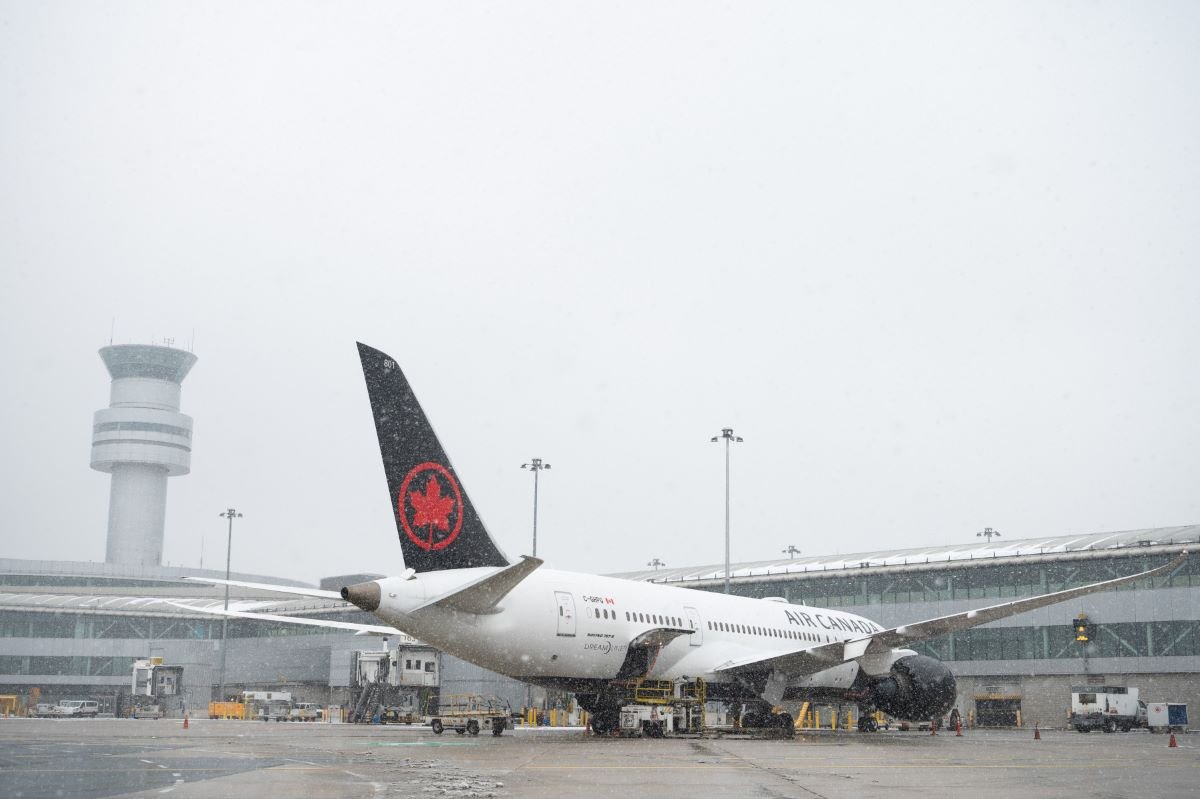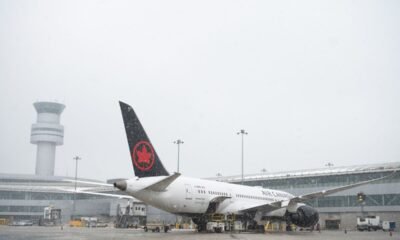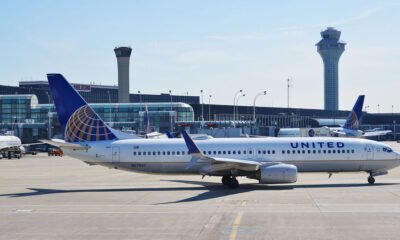Flight Buzz
Air Transat Expands to Brazil with New Nonstop Flights to Rio de Janeiro for Winter 2025-26

Published on
August 8, 2025 |
By: TTW News Desk
Air Transat is making a big push to Brazil with new nonstop flights from both Toronto and Montreal to Rio de Janeiro beginning in the winter 2025-26 season. The new offering is part of the carrier’s ongoing growth strategy focused on increasing presence in existing southern leisure and transatlantic markets.
New Service to Rio de Janeiro
The Canadian carrier will operate flights from Toronto Pearson to Rio de Janeiro Galeão International Airport twice a week, on Wednesdays and Saturdays. Additionally, it will offer a once-weekly service from Montreal-Trudeau Airport on Thursdays. All flights will be operated using the modern Airbus A330 aircraft, ensuring comfort and efficiency for travelers.
Following Air Canada’s announcement of its Toronto to Rio de Janeiro route set for December 2025, Air Transat introduces its own direct service to the Brazilian city. Until now, Montreal has lacked a direct link to Brazil, making Air Transat the first Canadian carrier to fill this gap, offering direct access to the Brazilian metropolis for the first time.
Market Insights
Brazil has long been a popular destination for Canadian travelers, with Toronto–São Paulo being the largest city pair between the two countries in 2024. Additional key routes feature flights from Montreal and Vancouver to São Paulo. According to Sabre Market Intelligence, Canada–Brazil traffic saw 352,000 passengers in 2024, marking a slight decrease of 1.6% from the previous year. Despite this, the demand for direct routes to Rio de Janeiro has remained strong, especially with Air Transat now serving as a direct option from Montreal and Toronto.
A Strategic Network Expansion
This new route to Brazil is a key element of Air Transat’s broader plan to enhance its network during the winter 2025-26 season. The airline is adding 14 new routes and increasing frequencies across key markets, reflecting a roughly 6% increase in capacity year over year. Alongside Brazil, Air Transat is also launching new routes to Guadalajara, Valencia, Madrid, Bordeaux, and Istanbul. This expansion will not only increase the airline’s footprint in the southern leisure markets but also cater to the growing demand for transatlantic travel.
New Routes from Smaller Markets
In addition to these new international destinations, Air Transat will also operate seasonal flights to popular Southern destinations from smaller Canadian markets such as Charlottetown, Windsor, and Fredericton. This move is aimed at providing more Canadians with access to international destinations, while also tapping into underserved markets.
A New Era of Connectivity Between Canada and Brazil
Air Transat’s entry into the Brazil market signals a new era of connectivity between Canada and Brazil, especially for Montreal residents who have previously had limited direct flight options to Rio de Janeiro. The new service will provide a convenient and seamless travel experience, catering to the growing demand for international leisure travel to one of South America’s most iconic cities.
With the expansion of its network, Air Transat continues to position itself as a key player in the competitive leisure travel sector. The new nonstop flights to Rio de Janeiro, alongside other seasonal additions, will further enhance the airline’s ability to meet the needs of travelers seeking new destinations and exciting holiday experiences.
Introduction of Rio de Janeiro and service to Brazil is also great news for Canadian travellers who can enjoy this new destination with Air Transat. With direct flights from Toronto and Montreal, the airline will prove to be an important driver of tourism development between Canada and Brazil. This expansion and additional routes will help to cement Air Transat’s status as the leader in leisure travel, accommodating the increased demands of vacation and business flyers.
Flight Buzz
Air Canada, WestJet, American and More Airlines Face New Travel Disruption as Over Dozens of Flights Cancelled at Toronto Pearson Airport in Canada Impacting Routes Including Vancouver, Copenhagen, San Francisco and more

Published on
August 8, 2025 |
By: TTW News Desk
At this time, Toronto Pearson International Airport is undergoing considerable operational challenges, with 138 noted flight delays and 12 flight cancellations reported across various airlines. The majority of delays and cancellations are on routes to and from major cities, including Vancouver, San Francisco, Chicago, LaGuardia, New York, and even international cities like Copenhagen and Regina, San Francisco, and Charlottetown. Air Canada appears to be the most affected, with 64 delayed flights and 5 cancellations, alongside other United Airlines, Air Canada Rouge and Jazz which also reported delays and cancellations on their routes. Passengers who are traveling to and from the impacted cities are advised to confirm their flight status before arriving at the airport.
Flight Disruption at Toronto Pearson International Airport
Today at Toronto Pearson International Airport, several airlines have reported significant delays and cancellations. Air Canada has been the most affected, with 64 delayed flights, making up 18% of its departures, and 5 cancellations, representing 1%. Air Canada Rouge experienced 4 cancellations (4% of its flights) and 11 delays (12%). United Airlines reported 2 cancellations (11% of its total flights) and 5 delayed flights (27%).
Jazz had 1 cancellation (0%) and 16 delays (12%). Other carriers with cancellations include British Airways (1 cancellation), Cathay Pacific (2 cancellations), and China Southern Airlines (1 cancellation), with 25-50% of their flights impacted. Lufthansa, Endeavor Air, Ethiopian Airlines, EVA Air, Flair Airlines, PSA Airlines, Korean Air, KLM, and Egypt Air also had delayed flights, ranging from 1 to 2 delays each. Airlines like Porter Airlines, Republic, Air Transat, and WestJet saw fewer delays, with Air Transat and American Airlines having 7 delays each (18% and 6% respectively).
The most affected routes from Toronto Pearson International Airport today include flights to Vancouver, Copenhagen, Chicago, Regina, San Francisco, LaGuardia, New York, and Charlottetown, with numerous delays and cancellations reported across these destinations.
A Closer Look at the Disruptions
Airlines and the Extent of Delays
The delays and cancellations have impacted a variety of airlines operating at Toronto Pearson. The delays are primarily due to a combination of factors, including weather conditions, air traffic control constraints, and operational challenges. Air Canada, the country’s largest carrier, has seen the highest number of delays, with 64 delayed flights, accounting for 18% of their total departures. Additionally, the airline had 5 cancellations today, contributing to 1% of their total flights. Other carriers with significant delays include Air Canada Rouge, United Airlines, and Jazz, which have also experienced notable disruptions.
A Breakdown of the Cancellations
Among the 12 cancellations, Air Canada and Air Canada Rouge saw the most, with the former having 5 cancellations and the latter contributing 4. This is followed by United Airlines, which had 2 cancelled flights. Other carriers affected by cancellations include British Airways, Cathay Pacific, and Ethiopian Airlines, with fewer cancellations reported across the board. While the situation at Toronto Pearson remains dynamic, travelers should expect potential ripple effects throughout the day.
How Major Airlines Are Handling the Disruptions
Air Canada’s Efforts to Manage Delays and Cancellations
Air Canada, as the largest airline at Toronto Pearson, has been at the forefront of handling the disruptions. Despite the significant number of delays and cancellations, the airline is working to accommodate affected passengers by providing alternative flights and compensation where applicable. According to a statement from the airline, they are committed to minimizing inconvenience and ensuring that passengers reach their destinations as quickly and comfortably as possible.
United Airlines and Other International Carriers
United Airlines has also seen substantial delays, with 27% of their flights delayed today. The airline, along with other international carriers such as British Airways and Lufthansa, has been actively communicating with passengers, advising them of any changes to their flight schedules. Passengers traveling on these airlines are advised to stay updated via the airline’s mobile app or website, as real-time updates on delays and cancellations are being provided.
Impact on Travelers and Tips for Navigating the Disruptions
Passenger Advice for Today’s Travel
With such a high number of delays and cancellations, it is crucial for passengers traveling through Toronto Pearson to stay informed. Checking the status of your flight regularly is the best way to ensure you are prepared for any changes. Airlines are increasingly offering mobile alerts to notify passengers about gate changes, delays, and cancellations in real time, which can help reduce stress during the travel process. Passengers experiencing significant delays need to reach out to their airline representatives for assistance with rebooking or compensation.
Potential Long-Term Effects on Toronto Pearson’s Operations
The ongoing delays and cancellations at Toronto Pearson could have a longer-lasting effect on travel operations, especially for flights departing in the next few days. The airport, which serves as a critical hub for both domestic and international flights, could continue to experience backlogs as airlines work to catch up on delayed schedules. Travelers are advised to allow extra time for check-in and security screening, as the volume of affected passengers may lead to longer wait times.
What’s Next for Toronto Pearson Airport?
Looking Ahead to a Busy Summer Season
As summer approaches, Toronto Pearson International Airport is expected to see even more traffic, which may put further strain on airport operations. Airlines, including Air Canada, WestJet, and others, are working to increase their preparedness to handle the expected surge in passengers. However, today’s disruptions highlight the need for airlines and airport authorities to enhance operational efficiency, particularly during peak travel periods. Travelers should expect continued updates regarding airport operations as Toronto Pearson adapts to these challenges.
Preparing for Ongoing Disruptions
Traveling through Toronto Pearson International Airport today can be stressful due to a high number of delays and cancellations. With 138 delays and 12 cancellations, passengers are advised to keep up with real-time updates from their respective airlines and to remain flexible in case of further changes. Air Canada, United Airlines, and other carriers are working to resolve the situation as quickly as possible, but passengers should anticipate potential delays through the day. For those traveling internationally or domestically, staying informed is key to navigating this disruption successfully.
Flight Buzz
United Airlines Cancel and Delay Over 650 Flights in US as Travel Disruption Continues in the Wake of a IT Outage, Including Denver, Miami, Houston, Los Angeles, Chicago, and More

Published on
August 8, 2025 |
By: TTW News Desk
A crippling IT outage sent United Airlines and its passengers into a two-day spiral of travel chaos this week, with the fallout from the resolved glitch continuing to disrupt operations across the US through Thursday. The failure of the airline’s critical “Unimatic” flight information system on Wednesday triggered a logistical meltdown that ultimately impacted over 1,700 flights. While the system was restored Wednesday night, the airline continued to struggle with displaced aircraft and crews, resulting in 164 cancellations and 489 delays on Thursday alone. This compounded the turmoil from the initial outage on Wednesday, which saw 218 flights cancelled and approximately 1,100 delayed, leaving thousands of passengers stranded at major hubs including Chicago, Denver, Houston, and Los Angeles.
As of Today, departure boards in United’s major hubs were still a sea of red, with 164 flights cancelled and another 489 delayed. This operational paralysis was the direct result of a far more intense breakdown on Yesterday, when the system failure first occurred, leading to 218 cancellations and a staggering 1,100 delays.
A massive two-day travel meltdown engulfed United Airlines this week after the failure of its critical “Unimatic” IT system, ultimately disrupting over 1,700 flights. The chaos peaked on Wednesday when 218 flights (7%) were cancelled and approximately 1,100 flights (35%) were delayed. The logistical fallout continued to plague the airline through Thursday, where another 164 flights (5%) were cancelled and 489 flights (15%) were delayed as the carrier struggled to reposition aircraft and crews. This widespread disruption was felt across the entire network, impacting routes of all types, from major international services like UAL146 between Newark and London, to key cross-country connections such as UAL796 from San Francisco to Boston and UAL2276 from Los Angeles to Chicago, and even shorter regional hops like UAL1476 from Denver to Kansas City, leaving thousands of passengers stranded at its major hubs.
The Anatomy of a Meltdown: A Legacy System Fails
At the heart of the crisis was a failure in United’s “Unimatic” system. This is a “legacy system”—older but essential software that acts as the digital backbone for the airline’s flight operations. It houses the foundational data for nearly every flight, including routing information, flight times, and critical weight and balance calculations needed for safe takeoff.
When Unimatic went down for several hours Wednesday night, it was like a nerve center being severed. Though IT teams managed to resolve the outage by late evening, the damage was already done. The incident, which United confirmed was not a cybersecurity breach, triggered a logistical domino effect that would take days to untangle.
The key problem is that a resolved IT issue doesn’t instantly put aircraft and flight crews back where they need to be. A plane that was scheduled to fly from Chicago to Los Angeles on Thursday morning might have been the same aircraft that was stuck on the tarmac in Denver the night before. Similarly, a flight crew’s legally mandated duty hours may have expired while they waited for a resolution, making them ineligible to pilot their next scheduled flight. This cascading failure of positioning and scheduling is why the disruptions continued long after the servers were back online.
Response and Nationwide Impact
As the crisis unfolded, the Federal Aviation Administration (FAA) stepped in, issuing a ground stop that halted United flights destined for its Chicago hub to prevent the airport from being completely overwhelmed. The impact was felt across the entire network, affecting flights of all types. Major cross-country services like UAL796 from San Francisco to Boston and key hub connections such as UAL2276 from Los Angeles to Chicago faced significant delays. The problems extended to international gateways, with flights like UAL146 from Newark to London Heathrow caught in the snarl. Even shorter regional routes, including UAL2074 from Denver to Rapid City, were not immune, illustrating how the failure of a single system could paralyze an entire network.
United’s public relations team worked to manage the fallout, issuing statements apologizing for the disruption and reaffirming that safety was its top priority. The airline assured customers it was working to rebook them and would cover expenses like hotels and meals in accordance with its policies.
Now, as the airline works to clear the backlog and restore a normal schedule, its larger challenge will be to restore the confidence of the thousands of passengers who were caught in the crossfire of a brief but catastrophic system failure.
Flight Buzz
American Airlines Announces New Flights To Budapest, Athens, And More For Summer 2026

Published on
August 8, 2025 |
By: TTW News Desk
American Airlines will broaden its international footprint in Summer 2026 by introducing six new routes serving vital markets in Europe and South America. This expansion not only deepens the airline’s footprint across the Atlantic basin but also provides U.S. travelers and those in Europe with additional, convenient nonstop choices. The new flights promise heightened schedule flexibility and streamlined connections for vacationers and business travelers alike.
The nonstop links will launch from Philadelphia (PHL), Dallas-Fort Worth (DFW), and Miami (MIA) and will span Budapest, Prague, Athens, Milan, Zurich, and Buenos Aires. These added markets complement the airline’s already robust transatlantic and South American portfolio and reinforce American’s commitment to increasing global service breadth and frequency.
American Airlines will for the first time offer seasonal service to both Budapest and Prague, thereby establishing nonstop access to the strategic and historically rich markets of Central Europe.
Philadelphia to Budapest and Prague
Commencing May 21, 2026, American Airlines will launch daily nonstop service from Philadelphia to Budapest and Prague, utilizing the Boeing 787-8 Dreamliner to bolster access to two culturally and historically rich capitals. The new Budapest route will represent the carrier’s inaugural service to Hungary, further underlining the increasing traveler interest in the nation’s famed thermal baths and UNESCO World Heritage sites. The nonstop service to Prague will also constitute the first direct link from Philadelphia, enabling convenient same-day arrivals to the Czech Republic’s storied cityscape of bridges, castles, and vibrant arts.
Dallas Fort Worth to Athens and Zurich
On the same date, American will add daily nonstop flights from Dallas Fort Worth to Athens and Zurich, employing the 787-8 for the Greek capital and the 777-200 for the Swiss metropolis. The new Athens route will meet surging demand for direct access to Greece’s storied coastline and island-hopping itineraries, while the Zurich service will connect U.S. travelers to the heart of the Swiss financial center, ski regions, and broader European high-speed train networks. Together, the new flights will affirm American’s role as a premier gateway for travelers seeking the Mediterranean and Central European experience.
Through the addition of these new links, Dallas/Fort Worth International Airport will solidify its position as a pivotal gateway for travelers journeying to Southern Europe. For travelers to Greece, the new Athens service will elevate the number of U.S. cities with nonstop flights to five, streamlining travel to the ancient capital. Zurich-bound passengers will benefit from a seamless connection to the Swiss financial heart, since these direct flights will now depart from one of the nation’s largest travel hubs.
Miami will acquire daily year-round service to Milan’s Malpensa Airport starting March 29, 2026. The new flight will further cement American Airlines’ extensive network at Miami International Airport, already among its most vital hubs. Milan’s rich cultural scene, fashion heritage, and robust business environment will now be within nonstop reach of South Florida, tightening the transatlantic bond between the U.S. and Italy.
The flight will close a longstanding gap in transatlantic connectivity, offering a direct link between Miami and Milan that eliminates the inconvenience of layovers and provides business and leisure travelers with a streamlined option.
Service Expansion to South America
In conjunction with its planned growth throughout Europe, American Airlines is set to broaden its footprint in South America. Beginning May 21, 2026, the airline will add a seasonal extension to its Dallas-Fort Worth to Buenos Aires (EZE) service, operating weekly across the Continental summer travel period and concluding on August 3, 2026. This additional capacity is designed to accommodate robust demand for travel between the United States and Argentina while reinforcing American Airlines’ strategic positioning as a leading carrier for the South American market.
By complementing existing Miami schedules with added Dallas-Fort Worth frequencies, American Airlines will provide the itinerary flexibility and connectivity that business and leisure passengers require when travelling to Buenos Aires.
Dedicated Options for Sports Travelers
In service to international sports marquee events in 2026, American Airlines will similarly offer a limited-time seasonal service connecting Dallas-Fort Worth and Zurich (ZRH) and will grow frequencies from Miami and Dallas-Fort Worth to Buenos Aires (EZE). The Zurich flights will operate from May 21 through August 4, 2026, and will be the only nonstop link between the two cities. This offering is tailored for sports enthusiasts travelling to Zurich for the 2026 FIFA World Cup and a calendar of associated global tournaments.
American Airlines will bolster its service to Buenos Aires during next summer’s peak season by adding up to three additional daily departures from Miami, providing travelers to Argentina with greater flexibility and connection options.
To further elevate the passenger experience on long-haul sectors, the carrier will increase the premium seat count on flights to Asia and Europe. Effective March 29, 2026, Dallas/Fort Worth will introduce daily Boeing 777-300ER service to Tokyo Haneda, raising the number of premium seats by more than 45 percent compared to the summer of 2025. Los Angeles, meanwhile, will double its Haneda footprint, operating two daily 777-200 flights.
Every long-haul service to Asia will come equipped with sleeping attire, memory foam mattress toppers, multicourse dining, and an expanded selection of award-winning wines, aligning the travel experience with the carrier’s emphasis on comfort.
America’s Summer 2026 expansion reaffirms its commitment to enhancing international reach. Launch routes to Budapest, Prague, Athens, Milan, Zurich, and the newly expanded Buenos Aires schedule collectively deliver greater choice and convenience to the airline’s passengers as travel demand continues to rise.
These new routes further enhance American Airlines’ extensive global network while consolidating its status as a frontrunner in transatlantic and intercontinental service. Ongoing growth is accompanied by a sustained dedication to delivering superior service and premium cabin offerings, guaranteeing that every traveler enjoys a smooth and gratifying journey from departure to arrival.
(Source: American Airlines, U.S. Department of Transportation, Airlines for America, International Air Transport Association)
-

 Brand Stories3 weeks ago
Brand Stories3 weeks agoBloom Hotels: A Modern Vision of Hospitality Redefining Travel
-

 Brand Stories2 weeks ago
Brand Stories2 weeks agoCheQin.ai sets a new standard for hotel booking with its AI capabilities: empowering travellers to bargain, choose the best, and book with clarity.
-

 Destinations & Things To Do3 weeks ago
Destinations & Things To Do3 weeks agoUntouched Destinations: Stunning Hidden Gems You Must Visit
-

 Destinations & Things To Do2 weeks ago
Destinations & Things To Do2 weeks agoThis Hidden Beach in India Glows at Night-But Only in One Secret Season
-

 AI in Travel3 weeks ago
AI in Travel3 weeks agoAI Travel Revolution: Must-Have Guide to the Best Experience
-

 Brand Stories1 month ago
Brand Stories1 month agoVoice AI Startup ElevenLabs Plans to Add Hubs Around the World
-

 Brand Stories4 weeks ago
Brand Stories4 weeks agoHow Elon Musk’s rogue Grok chatbot became a cautionary AI tale
-

 Brand Stories2 weeks ago
Brand Stories2 weeks agoContactless Hospitality: Why Remote Management Technology Is Key to Seamless Guest Experiences
-

 Asia Travel Pulse1 month ago
Asia Travel Pulse1 month agoLooking For Adventure In Asia? Here Are 7 Epic Destinations You Need To Experience At Least Once – Zee News
-

 AI in Travel1 month ago
AI in Travel1 month ago‘Will AI take my job?’ A trip to a Beijing fortune-telling bar to see what lies ahead | China













You must be logged in to post a comment Login